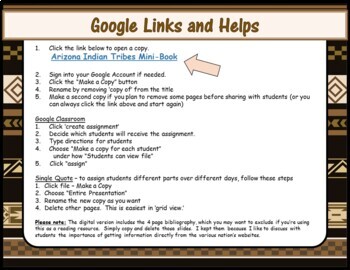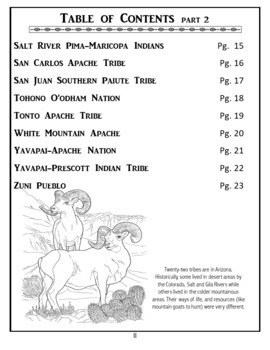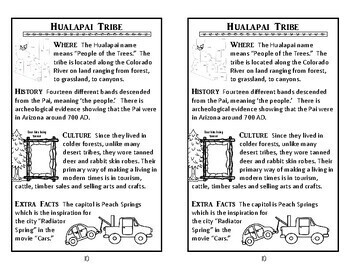Arizona Indian Tribes Mini Book - Now DIGITAL too!
- Zip
What educators are saying
Description
Arizona Tribes Mini-Book –
Now with FULL-Size, Mini-book and Google Slide versions!
Find the Google link in the PDF.
Please see the preview.
Meet the new Arizona Social Studies Standards by getting to know about all the Federally Recognized Tribes in Arizona. Please note – the names used on each page were taken from the sovereign nations, some call themselves ‘tribes,’ some ‘nations,’ and others 'Indian communities."
This minibook includes
· All 22 tribes (2 pages for Navajo – one of the largest in America)
· Full bibliography for continued study
· 3 Barn fold pages for taking notes
· A full-page map of all tribes
· Each page includes a map for that nation
· Print friendly graphics on each page
· Range of topics (since there are several nations from the same people, a different aspect of their history is on each page)
Arizona Social Studies Addressed in the mini book
• Students will study Arizona within an integrated approach considering the following factors: The contributions of various cultural and ethnic groups including the 22 Indian Nations that reside in Arizona.
• The use of geographic representations and tools helps individuals understand their world.3.G1.1 Use and construct maps and graphs to represent changes in Arizona over time. Key concepts include but are not limited to distinct physical and cultural characteristics of Arizona including landforms, the 5C’s, climate zones, elevations, plants, animals, Arizona’s 22 Indian Nations, diverse ethnic, racial, and religious cultures
• 3.G2.1 Explain how people modify and adapt to the Arizona environment. Key concepts include but are not limited to modification and adaptation of the environment by Paleo-Indians, Prehistoric-Indians, explorers, settlers, farmers, immigrants, migrants, and the 22 Arizona Indian Nations, and the use of Arizona’s natural resources.
• 3.G4.1 Describe how Arizona has changed over time. Key concepts include but are not limited to Paleo-Indians, explorers, settlers, farmers, immigrants, migrants, the 22 Arizona Indian Nations, plants, land use, and animals.
• 3.H2.1 Use primary and secondary sources to generate questions about the causes and effects of conflicts and resolutions throughout Arizona’s history. Key concepts include but are not limited to conflicts over exploration, colonization, settlement, industrialism, and the 22 Arizona Indian Nations
Arizona Nations
1. Ak-Chin
2. Cocopah
3. Colorado River Indian Tribes
4. Fort McDowell Yavapai Nation
5. Fort Mojave Indian Tribe
6. Fort Yuma-Quechan Tribe
7. Gila River Indian Community
8. Havasupai Tribe
9. Hopi Tribe
10. Hualapai Tribe
11. Kaibab Band of Paiute Indians
12. Navajo Nation
13. Pascua Yaqui Tribe
14. Salt River Pima-Maricopa Indian Community
15. San Carlos Apache Tribe
16. San Juan Southern Paiute Tribe
17. Tohono O’odham Nation
18. Tonto Apache Tribe
19. White Mountain Apache
20. Yavapai-Apache Nation
21. Yavapai-Prescott Indian Tribe
22. Zuni Pueblo
Updates
2019 Sept. 30 Fixed the digit missing on page for Zuni from 2 to 23
2019 Nov. 9 The school copier threw a little fit and refused to print the maps clearly, so I made them darker.
2020 Nov. 10 I made additional copies half price. Buy 2 copies to share with a team up to 5 members.
2021 Jan. 4 I just added a full size version which is easier to see online. I also included a folder with each page as a PNG picture to be used as a background in Google Slides. Also I changed typo on page 6 "is" to "it".
2021 Jan. 22 This now includes a digital Google Slides version with a help page for using it. The price has been raised to reflect the additional version (now 3 versions). Download again for free if you already own it. (PNGs removed)
Thank you for your interest in Creative Core Integrations by Kim Shelley!
Click here to *Follow Me* for 50% off new products for the first 48 hours.
The Arizona ELA Bundle includes graphics purchased from these creative talents:
https://www.teacherspayteachers.com/Store/Whimsy-Clips
https://www.teacherspayteachers.com/Store/Hidesys-Clipart
https://www.teacherspayteachers.com/Store/Rebeccab-Designs
https://www.teacherspayteachers.com/Store/Artifex
http://www.teacherspayteachers.com/Store/Educasong
https://www.teacherspayteachers.com/Store/Zip-a-dee-doo-dah-Designs
https://www.etsy.com/shop/oldmarket





